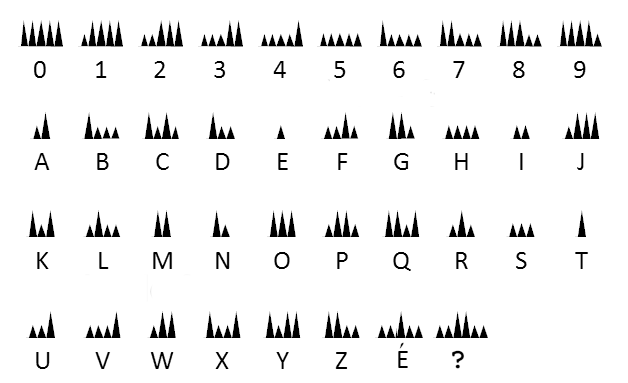Recently I was recently reading a science fiction novel. The crew of a spaceship are without power, and have to warn another ship to keep its distance. They can be seen at a window. They resort of pantomiming “pushing‑away” actions. Using Morse code does not seem to occur to them.

How do you use Morse code without electricity? There are ways to do this, and they are possibly not so well known as some other methods.
Manual Morse
The first method is taken from this useful website. It has a passing resemblance to semaphore, but uses standard Morse code, which is far more likely to be known by the sender or viewer.
I call this system “Manual Morse”.

You do not need to have flags to use this system. You can use the motions if your hands are empty. Holding a scarf, bandana or branch in each hand may be used to make your motions more visible. Coloured stuffsacks may be stretched over a flexible stick bent into a racket-shape.
Depending on the background, taking off dark‑coloured gloves or wearing lighter gloves may aid empty‑handed signalling.
Flag Morse
Back when I was blogging about American Civil War outfits, I read the book “Hardtack and Coffee”. A fascinating book, which finished with a chapter on the pre‑Morse signalling system used during the war.
This system may also be used with Morse code, and may be still referred to as “wigwag” or “wig‑wag”.
I prefer to call it “Flag Morse”.

The convention here is a little different to that used with two‑flags. Flag up is “ready” or “word begins” rather than “dot”.
“Dot” (Two) is starboard: to the right of the signaller, to the left of the observer. Easily remembered because we read from left to right in English.
“Dash” (One) is port, as in “a dash of port”.
No flag? You can use the single pole/Flag Morse method with a rifle, a hiking pole or a branch. Add a scarf to the end or anything else that makes your signal more visible.
You can also clasp your hands together as though you are about to dive and point your straightened arms up, down, left and right. Point them straight ahead between dots and dashes.
That said, my personal feeling is that the two-flag/Manual Morse method is better for empty handed signalling. The shapes made are more distinct and wider or taller.
In these days of electronic warfare and eavesdropping, such simple visual methods of signalling still have a place.
Establish a shorthand of one, two and three letter signals.
Non‑Electric Morse at Night
If you want to signal at night, you may flash a light. If your light cannot easily be turned on or off, you may be able to cover it with your hand, hat, map or similar.
This is not so easy if you are using a light source such as a burning brand. When viewed at a distance at night, a single light source can appear to move about even when it is not moving. “Hardtack and Coffee” tells us:
“The services of the Signal Corps were just as needful and valuable by night as in daylight; but, as the flags could not then talk understandingly, Talking Torches were substituted for them. As a “point of reference” was needful, by which to interpret the torch signals made, the flagman lighted a “foot torch,” at which he stood firmly while he signalled with the “flying torch.” This latter was attached to a staff of the same length as the flagstaff, in fact, usually the flagstaff itself. These torches were of copper, and filled with turpentine. At the end of a message the flying torch was extinguished.”
Our spacemen in the book could have used a non‑electric method of Morse signalling. Perhaps a piece of material with a different symbol and/or colour drawn on each side.
Later in the book the natives of a planet signal using a pivoted disc painted white on one side, black on the other. It is commented that this is the local equivalent to Morse.
Morse by Sound
Morse signalling with sound was not an option for the spacers.
Often in movies, someone will bang on pipes and a character will identify it as “Morse code”. Morse needs two distinct signals, so most Morse letters cannot be transmitted with a single note such as a tap on a pipe. The code you need for this is POW tap code.
One of the few messages you can transmit with a single note is SOS (…—…). With a signal whistle, you make three short blasts, three longer blasts, then three more short, no pauses between the letters.
If you are drumming against a tree trunk or piece of wreckage, you cannot do this. Instead you vary the interval between the notes: three quick notes, three notes with a longer pause after each, then three more quick.
I have recently updated my blog on learning Morse with some new reference and some new tricks to help you remember certain letters.